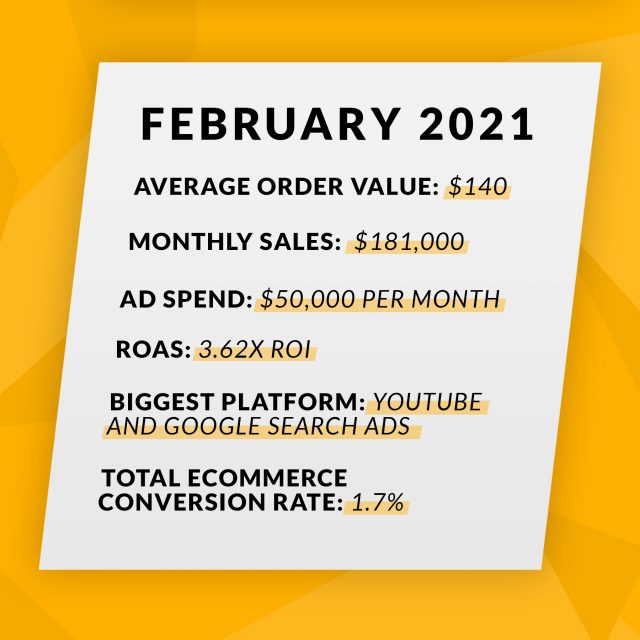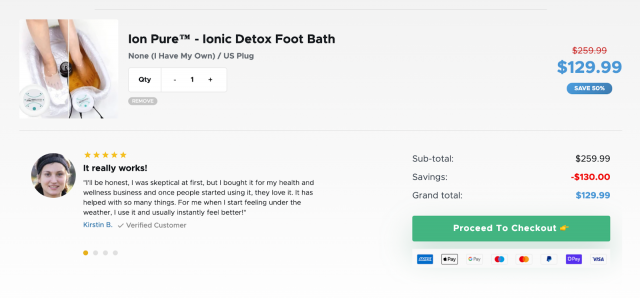In today’s advertising market there’s a million-dollar question that everyone has.
“How can I increase my sales WITHOUT increasing my ad spend?”
Legends say those who are capable of doing this have already ascended to marketing mount olympus and have tea time daily with Russel Brunson and Gary Vee…
Seriously though.
Especially after 2020, ad costs have been rising faster than ever, THEN we got all these lovely IoS14 updates to make things even more interesting for us.
So what’s the answer?
How have we been outpacing the market changes to generate EVEN HIGHER ROI than before?
That’s exactly what you’re about to learn.
Here’s the snapshot on the down low of how this business looked before we implemented our strategy and after.


Now let’s get into the timeless marketing tactics that we used to start generating an average of $40K more in sales monthly for this store with the EXACT same ad spend.
You’re going to laugh at this.
Because it’s way simpler than you’re probably thinking.
While all of the other marketers in the world were trying to find a way to lower ad costs, we added $40K/mo in sales with 3 stupidly simple split tests.
Now I want you to think about this.
Why try to find cheaper ads, when you can just focus on making more sales off of your existing traffic?
Here’s one thought we want you to take away from this guide.
Running Split Tests are FREE, and Have a Low Time Investment
So why do so few Ecommerce brands do it?
I’m honestly dumbfounded at how few brand owners focus on CRO.
Here’s the truth: If you own on an Ecommerce store and you haven’t implemented any conversion rate optimization tactics, you’ve got to get your priorities in order.
It’s as simple as that.
So, let’s dive into how we got this done.
Enter Client X, The Ecom Store Owner Struggling to Increase Profits.
This client asked for us not to share their domain for pretty obvious reasons, but Client X is an absolute legend and gave us the greenlight to share the rest of the case study!
When Client X approached us, he was exhausted because he was spending 3-4 hours a day on his ads.
Spending half of his work days on ads, and STILL struggling to drive more profit.
I told him the problem was not his ads… but his WEBSITE.
I always find it funny that Ecommerce business owners forget that their entire business is a website and rarely work on improving their website.
So back to Client X, here’s a quick rundown of how their numbers looked before we implemented CRO for them:

When they approached us we took them through our typical process:
- Install a heatmap on the website to see where the most people are clicking
- Look at Google Analytics to see where there’s the most dropoff (people leaving the site without continuing the buying process)
- Identify which demographics of people are buying the products (qualitative data)
- Identify where most of their revenue comes from? (products, specific URLs, traffic channels, etc)
*AHEM*
I hope you’re taking notes on this.
Seriously. Read those 4 steps above again and take them to heart if you’re serious about growing your store.
After this analysis, we identified three major problems with Client X’s website.
- They Had a High Bounce Rate on the Product Page → a LOT of traffic from their paid ads (mainly YouTube, but Facebook ads as well) would land on their product page and not click on anything on the page. Their bounce rate was >70%, which is very high. This was also very surprising that a store doing almost $250k per month had a bounce rate of >70%.
This means one thing to us. With some simple CRO, we could improve this number drastically, which directly influences sales and profit.
- They had a Low Add to Cart > Purchase Rate → the industry average Add to Cart to Purchase ratio is an average of 20-30%. This means if 100 customers Add to Cart, 20-30 of them will buy your product.
Client X had an 18% Add to Cart > Purchase ratio.
Again, for a store doing over $2 million a year, we’re just sad we didn’t get to them sooner, because they’ve been leaving so much revenue on the table. #GOLDMINE
- Unclear Upsell Method → for this product, there’s a $129 option, and a $179 option. They sell about 50/50 of each option, which was ANOTHER landmark opportunity to improve sales. In conversion rate optimization, there’s two major ways to improve revenue, increasing overall conversion rate, and increasing average order value.
If you can increase both at the the same time… you’ll get some pretty insane case studies, like the one you’re reading now
Client X’s homepage doesn’t get much traffic to the homepage, only 15% of traffic goes to the homepage. 60%+ of their traffic was to the product page of their top-selling product. This is where they pushed their traffic to from YouTube, so it all made sense.
This means we had to focus on their top-selling Product page and Cart page to have the biggest impact on revenue and conversion rate in the quickest period of time.
So here are the 3 split tests we decided to start with:
Test #1: Change the Product Title
Most marketers and Ecommerce founders don’t weigh the importance of having the perfect product title on their product page. They usually set a title when they create the store, and NEVER edit it again. Product title changes are always one of my first split tests I run on stores, because every single customer sees the product title.
If you’re Nike and selling sneakers, you don’t name your product “Sneaker” or “Athletic Shoe”.
You want to name it something like “Super Awesome Incredible Premium Maximum Leverage Really Comfortable Shoe”…
Just kidding, that’s just as bad.
You want to have some descriptive words and differentiation in your title, but not too much. Most new clients have too small of a title, but Client X actually had too much, so we ran a split test with two options, here is what Client X had before us:

“Professional-Grade Ionic Detox Foot Bath” is a bit too much description. The consumers seeing this may think that this is “too targeted” and ultimately “not for them” if it feels too specific.
So, we wanted language that clearly communicates what the product does, but not exclude anyone.
For example, the phrase “Professional-Grade” likely makes customers think this is for health professionals and not for consumers. This is the biggest observation we found, which became a massively profitable split test.

By changing the title, we created over $8,000 of new revenue per month. This made an 8% increase in TOTAL conversion rate for Client X.
Test #2: Increase Price Size and Savings
Before, the cart looked a bit empty and not much in it. The red and blue were things we wanted to fix, but we wanted the first split test (in the cart) that would have the largest impact.
Two things are most important in the cart page:
- The customer feels they’re getting good value for the money they’re spending.
- The client trusts that you will deliver on your promise
Often in many Shopify and WordPress themes, the price representation (the actual $ value, visually speaking) is very small. If a price is buried, even at a high price point, loses trust with customers.
For this reason, we ran a test to increase the size of the price ($129.99) and add a cost savings element (Save 50%). These two together seem to be a strong combination we’ve found work for many clients.

The results of this test were just as significant, as it increased Add to Cart > Purchase Ratio by 25%.
Client X loves us, by the way. After these two tests alone, he’s going to make an additional $300,000 over the next 12 months.
Test #3: Upsell Communication
For Client X’s product, a detoxifying foot bath, there’s two product options.
With the foot tub, or without the foot tub.
Obviously, Client X wants to sell them at the highest price possible, always adding the foot tub in. This adds an additional $60 to the Average Order Value, which is one of the most important metrics when working on conversion rate optimization.
If we properly communicate WHY they need it, the customer confidence will increase, and so will average order value.
So, when Client X came to us, the exact text read:
“Foot Tub Options – None (I have My Own)”

This is not very clear for a number of reasons. The most important one is that “None (I Have My Own)” is too suggestive, and telling the customer what they have or don’t.
The customer needs to feel in control of their purchase, so we changed the text to the following:
“Do I Need A Foot Tub?”

Again, this puts the customer 100% in control of their purchase, and helps the internal narrative of them making decisions on the site as they purchase.
This was our biggest winning split test, adding $5,000 per month of new revenue by increasing Average Order Value by 15%.
The devil is in the details folks.
These are just the first few split tests we ran for this store, and we continue to test more aspects of the store to drive revenue higher and higher on a monthly basis, without increasing ad spend.
So after our 3 first split tests (which only took a few weeks to execute), here’s what the new stats looked like:

We’ve got plenty more split tests to run that will continue the steady charge upward for this store.
As our subscribers are probably tired of hearing us talk about, what is most important about our CRO tactics is that they focus on increasing PROFIT above all.
By increasing the conversion rate and keeping ad spend the same, not only is the store now generating $70K more in sales monthly (so far,) but every single sale is more profitable because the cost per customer acquisition is lower.
A penny saved is a penny earned.
Except in this situation when you save a penny, you also earn more pennies.
If that makes any sense…
I think you get the point.
If you haven’t been focusing on CRO and you run an Ecommerce business NOW is the time to make it your top priority.
If you care about generating more profit for your store, without having to dump more money into ads, CRO is your answer.
If your margins are disappearing because of increasing ad costs, guess what?
CRO is your best option to stay ahead of your competition.
If you like hearing a biased opinion from CRO specialists about how CRO is the answer to all of your problems, you’re reading the right blog post.
The results speak for themselves.
Can you think of any other way to increase your sales so drastically without increasing your overhead proportionately?
Doubt it.
So stop sleeping on split testing.
Get instant access to 5 more of our simple split tests that you can run to grow your brand by signing up here!
Don’t get left behind as the E-commerce market is shifting.
Get ahead.





